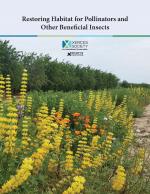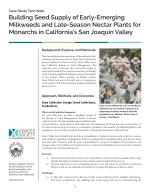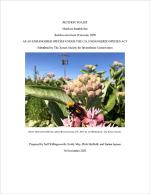As a science-based organization, the Xerces Society produces dozens of publications annually, all of which employ the best available research to guide effective conservation efforts. Our publications range from guidelines for land managers, to brochures offering overviews of key concepts related to invertebrate conservation, from books about supporting pollinators in farmland, to region-specific plant lists. We hope that whatever you are seeking—whether it's guidance on making a home or community garden pollinator-friendly, advice on developing a local pesticide reduction strategy, or detailed information on restoring habitat—you will find it here!
Find Publications
Use the search functions to sort by publication type (books, guidelines, fact sheets, etc.), location, and/or subject (agriculture, gardens, pollinators, pesticides, etc.).
Habitat for Predators and Parasites
This brochure illustrates how farmers can attract and retain helpful predators and parasites by providing some of the key resources that they require.
Las Abejas Nativas y Sus Cosechas
A Spanish translation of the brochure Farming for Pollinators.
Este folleto proporciona un resumen de los requisitos de hábitat de los polinizadores de cultivos y su hábitat se puede encontrar en el área alrededor de una granja.
To see the full list of brochures available for download, click here.
Native Bees and Your Crops
This brochure provides a summary of the habitat requirements of crop pollinators and where their habitat may be found in the area around a farm.
To see the full list of brochures available for download, click here.
Guidelines for Planning, Preparation, Design, Installation, and Maintenance
Native meadows, filled with perennial wildflower mosaics and waving grasses, are growing in popularity with property owners and designers because they provide benefits to people, pollinators, and wildlife while demonstrating sustainability values. These meadowscapes offer economic and ecological advantages over intensively managed horticultural landscapes. Seeded meadows are low-input alternatives to containerized plantings or certain turf spaces, and so they have a role to play in institutional, commercial, and multifamily residential projects.
This document provides a visual overview of the Xerces Society's work with private sector partners to plan, install, and develop maintenance plans for pollinator habitat sites at facilities, offices, on supply chains, and more; as well as to help farms become Bee Better Certified.
Anthricinan Yellow-Faced Bee (Hylaeus anthracinus)
The purpose of this technical note is to provide guidance to NRCS and partner agency staff when protecting, designing, and installing habitat for Hylaeus anthracinus, known simply as the anthricinan bee, a rare yellow-faced bee listed as an endangered species by the U.S. Fish and Wildlife Service.
The western monarch population is at a critically low level. Work to improve monarch habitat in California is more important than ever. This fact sheet identifies the most important actions that should be taken in five different regions of California, and provides notes and guidance on selecting the appropriate species of milkweeds and nectar plants.
This fact sheet provides a quick overview of the estimated costs of establishing wildflower habitat for pollinators on conventional farms without restrictions on general herbicide use.
This fact sheet outlines the estimated costs of establishing wildflower habitat for pollinators using a method referred to as solarization.
This fact sheet outlines the estimated costs of establishing pollinator hedgerows habitat from transplants.










